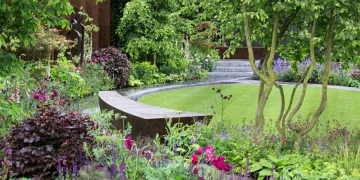A staple on London’s social calendar, the origins of the Chelsea Flower Show go back hundreds of years.
Formally known as the Great Spring Show, this event has taken place every year - with the exceptions of gaps during the two World Wars and the 2020 pandemic - and remains the most prestigious flower show in British history. It is outdone in size only by the RHS Hampton Court Palace Garden Festival, but is still an occurrence that thousands flock to every year.
But how exactly did the Chelsea Flower Show become the floral extravaganza we know and love today?
Back to the Beginning
Despite its name, the origin story of the Chelsea Flower Show doesn’t actually begin in Chelsea, but in Chiswick. From 1833, the Royal Horticultural Society (RHS) held flower shows in their Chiswick garden. Kensington Garden was later chosen as the site due to falling visitor numbers in Chiswick, largely due to poor transport links.
These fête-like events, which combined plant displays with social gatherings, quickly became fashionable and popular, which eventually led to the establishment of the Great Spring Show in 1862.
Following the closure of the RHS Kensington Garden in 1888, the Great Spring Show made the move to the Inner Temple Gardens on London’s Embankment. There it would stay and take place every year until 1911.
The Move to Chelsea
In 1913, Sir Harry Veitch, renowned English horticulturalist, was able to secure the grounds of the Royal Hospital, Chelsea for that year’s event. It proved to be the perfect fit and the Chelsea Flower Show had found its permanent home.
For the 1913 show, so many exhibitors applied to be featured that only half were able to be accommodated - around 244!
The show consisted of a single huge tent encompassing over two acres and containing 84 ‘large groups of flowers, plants and shrubs’ with around 95 exhibition tables. Outside were 17 gardens, each showing various floral-based feasts for the eyes based around the popular horticultural trends at the time.
This initial show was - without a doubt - an incredible success. It cost £3,365 to hold and made a profit of £88. While that may not sound like much, in today’s money this equates to £150,000 and £4,000 respectively.
The 20th Century
The success of the Chelsea Flower Show continued over the years and the event continued to evolve with the times, whilst also building up traditions. Royal visits were common; Queen Alexandra opened the first Chelsea Show in 1913, was a regular visitor and became the show’s first patron.
The first disruption to the show’s regular instalments came in the form of the first World War. Although the show continued from 1914 to 1916, it was cancelled in 1917 and 1918. By the 1920s, the Chelsea Flower Show had returned to its usual grandeur; the famous tea parties were established and the Royal Family resumed their visits. In 1927, the show was expanded to take place for four days, after initially being a three-day event.
World War II forced a longer hiatus, as the War Office required the land for an anti-aircraft site. After much worry over whether the show would resume in 1947 - due to low plant stocks, depleted staff numbers and fuel shortages - normal activities successfully resumed. Instead of hosting the flower show during this turbulent time, the RHS turned its focus to the ‘Dig for Victory’ campaign, which encouraged people to grow their own food.
Unprecedented Popularity
Despite having 11 acres of land, the popularity of the Chelsea Flower Show started to cause problems. There have been occasions in the past where turnstiles have been closed to prevent dangerous overcrowding and in 1988 the RHS decided to limit daily ticket numbers to 40,000. The decision was also made to charge RHS members admission for the first time.
In 1958, the BBC started to cover the flower show on television. Despite it already being a key fixture in the social calendar and incredibly popular, the BBC’s coverage took it even further. Starting with one programme, coverage of the Chelsea Flower Show now encompasses the whole week with millions tuning in to watch.
In 2005, the show was expanded to five days, with two days reserved for RHS members and it’s estimated that around 160,000 visitors stop by each year.

Chelsea Barracks at the Flower Show
In 2016, Chelsea Barracks made a significant impact at the Flower Show, with an award winning garden exhibition designed by landscape architect Jo Thompson. The display incorporated elements that celebrated the site's heritage while also embracing its future as a thriving community and was awarded with a ‘Best in Show’ gold medal.
The exhibit featured a combination of lush greenery, vibrant flowers, and carefully curated landscaping, creating a visually stunning tableau that captivated visitors.
Thompson was later an integral part of the design and installation of both Mulberry Square and Bourne Walk.
The Last Day
At 4pm on the last day of every Chelsea Flower Show, a bell rings. This bell signifies the start of the great plant sell off, when exhibitors are allowed to start selling any plants they don’t want to take away.
In more recent years, the RHS has been keenly focused on reducing waste from the flower show. This focus is conveyed to exhibitors, who are encouraged to plan their show gardens with a second, permanent home in mind, with plants being carefully taken away and replanted. Materials such as wood, bricks, woodchip and compost are passed onto community groups to reuse.
As for what happens next… Well, it’s onto next year’s show!


